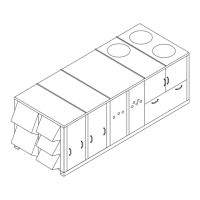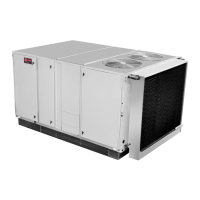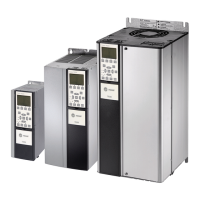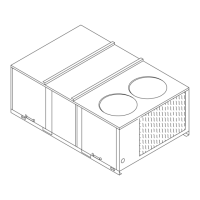72 RT-SVX34C-EN
Startup
The 2.2% imbalance in this example exceeds the maximum allowable imbalance of 2.0%. This
much imbalance between phases can equal as much as a 20% current imbalance with a resulting
increase in motor winding temperatures that will decrease motor life.
If the voltage imbalance at the job site is over 2%, notify the proper agencies to correct the voltage
problem to within 2.0% before operating this equipment.
Starting the Unit
Before closing the main power disconnect switch, insure that the "System" selection switch is in
the "Off" position and the "Fan" selection switch for Constant Volume units is in the "Auto" position.
Close the main power disconnect switch and the unit mounted disconnect switch, if applicable.
WARNING
Live Electrical Components!
During installation, testing, servicing and troubleshooting of this product, it may be necessary
to work with live electrical components. Have a qualified licensed electrician or other individual
who has been properly trained in handling live electrical components perform these tasks.
Failure to follow all electrical safety precautions when exposed to live electrical components
could result in death or serious injury.
HIGH VOLTAGE IS PRESENT AT TERMINAL BLOCK HTB1 OR UNIT DISCONNECT SWITCH.
Upon power initialization, the RTRM performs self-diagnostic checks to insure that all internal
controls are functional. It also checks the configuration parameters against the components
connected to the system. The LED located on the RTRM module is turned "On" within one second
of power-up if internal operation is okay. The economizer dampers are driven open for 5 seconds
then fully closed (if applicable).
When an economizer is installed DO NOT ENTER the TEST mode until all calibration startup
functions have been completed. Otherwise, the economizer actuator and power exhaust output
may not function properly during any of the test mode steps. Allow 2 minutes after unit power up
to complete economizer calibration before entering the test mode function.
Use the following "Test" procedure to bypass some time delays and to start the unit at the control
panel. Each step of unit operation can be activated individually by temporarily shorting across the
"Test" terminals for two to three seconds. The LED located on the RTRM module will blink when
the test mode has been initiated. The unit can be left in any "Test" step for up to one hour before
it will automatically terminate, or it can be terminated by opening the main power disconnect
switch. Once the test mode has been terminated, the LED will glow continuously and the unit will
revert to the "System" control, i.e. zone temperature for constant volume units or discharge air
temperature for variable air volume units.
Test Modes
There are three methods in which the "Test" mode can be cycled at LTB1-Test 1 and LTB1-Test 2.
1. Step Test Mode - This method initiates the different components of the unit, one at a time, by
temporarily shorting across the two test terminals for two to three seconds.
For the initial startup of either a Constant Volume or Variable Air Volume unit, this method allows
the technician to cycle a component "on" and have up to one hour to complete the check.
2. Resistance Test Mode - This method can be used for startup providing a decade box for variable
resistance outputs is available. This method initiates the different components of the unit, one
at a time, when a specific resistance value is placed across the two test terminals. The unit will
remain in the specific test mode for approximately one hour even though the resistance is left
on the test terminals.
3. Auto Test Mode - This method is not recommended for startup due to the short timing between
individual component steps. This method initiates the different components of the unit, one

